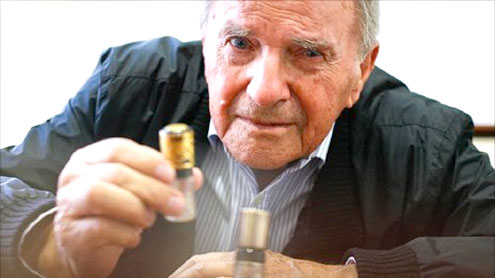 In 1943, 24-year-old Peter Florjancic, then known as an Olympic ski jumper representing Yugoslavia, expected to be called up to fight for the German army on the Russian front.He decided instead to flee. On 17 April, he and a friend boarded a train from the sleepy lakeside resort of Bled in German-occupied northern Slovenia.Part of the way through their contrived skiing holiday in Kitzbuehel, Austria, they would cross the mountain border to neutral Switzerland, while making it look as if they had perished on the slopes of the avalanche-prone Hahnenkamm.No-one would be able to find out the truth, without endangering their life.Florjancic would not return to Bled for more than 50 years, time he used to make and blow several small fortunes – and in doing so hobnob with the social elite of the day.”I was always interested in famous people,” he says.Before the war had even ended, he had made a pile of money.
In 1943, 24-year-old Peter Florjancic, then known as an Olympic ski jumper representing Yugoslavia, expected to be called up to fight for the German army on the Russian front.He decided instead to flee. On 17 April, he and a friend boarded a train from the sleepy lakeside resort of Bled in German-occupied northern Slovenia.Part of the way through their contrived skiing holiday in Kitzbuehel, Austria, they would cross the mountain border to neutral Switzerland, while making it look as if they had perished on the slopes of the avalanche-prone Hahnenkamm.No-one would be able to find out the truth, without endangering their life.Florjancic would not return to Bled for more than 50 years, time he used to make and blow several small fortunes – and in doing so hobnob with the social elite of the day.”I was always interested in famous people,” he says.Before the war had even ended, he had made a pile of money.
Shortly after arriving in Bern, Switzerland, he patented a weaving machine designed for use by disabled people – men wounded in the war, for example – and made 100,000 Swiss francs from it.”It was enough to buy three luxury houses,” he says.But Florjancic spent much of it on living the high-life in Davos and Zurich, where he met his wife.After the war ended, a holiday to Monte Carlo in 1950 turned into a 13-year stay. A poolside meeting with Ilhamy Hussein Pasha, an associate of King Farouk of Egypt, resulted in a long collaboration, during which Florjancic invented a perfume atomiser spray that is still in use all over the world today.From Monte Carlo he moved to Villach, Austria, in 1963, where he would invent plastic ice-skates and the plastic photographic slide frame.”Gold lies on the streets and you just need to dig it up with ideas. Ideas are like the shovel,” he says.But not every one of Florjancic’s ideas has unearthed pots of gold. His name appears on more than 230 patents, including ones for a drinking straw holder and an ice spear for chilling drinks.The world has also largely overlooked the advantages of a broad belt to help couples dance in time and the benefits of a shoe guard for drivers wanting to prevent their heels getting scuffed.
And, sometimes, he has failed to pursue an idea which would later take off, like the safety airbag for cars which he sketched in 1957, but never managed to build without the bags exploding.The plastic zip fastener was another near miss, dating from the Monte Carlo years.”I made this zipper in 1948 with plastic material and people were enthusiastic about it. We washed it, and everything was perfect,” Florjancic says.”Then we ironed the jacket – but we couldn’t get the zipper open any more, because it had melted. The champagne we had ready to celebrate, we drank in sorrow not in success.Florjancic withdrew the patent, and earned nothing from the plastic zip’s eventual triumph, when it was re-invented by someone else using tougher materials.But his successes were plentiful enough to enable him to indulge his desire to move in elevated circles.”I was at the right place at the right time,” he says. The right places included some of Europe’s most extravagant hotels.Born into a hotel-owning family, he then spent 25 years living in them. Even now his office is just off the dining room of a hotel overlooking Lake Bled, walls covered with pictures of famous people he has met.The listing of the famous names fills any lull in conversation. He sat next to Winston Churchill in the gambling table in Monte Carlo. He was invited to play boules with Konrad Adenauer.
As a child in Bled he spoke to members of Yugoslavia’s Karadjordjevic dynasty and Edward and Wallace Simpson.He once saw King Farouk having 1m Swiss franks brought to the gaming table on a dozen plates. He appeared in the 1957 film The Monte Carlo Story with Marlene Dietrich. And he shook the hand of Nazi leader Heinrich Himmler while competing in the ski jump in the 1936 Winter Olympics.His favourite person of all of them was nautical polymath Jacques Cousteau. “He was a very interesting man and knew everything about the sea,” he says.And what did the famous people find interesting about a Slovenian inventor?”They were always interested in my story. The story of my escape. I was always telling my story,” says Florjancic.He finally returned to Slovenia in 1998.”I told my mother that I would come back to Bled to die. I thought that was going to be back in 2000,” he says.But there is no let up for the 92-year-old.”I have no pension,” he says. “Only when you work do you have a clear head.” – BBC












